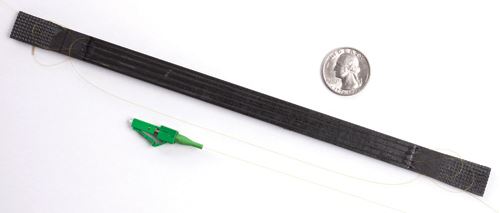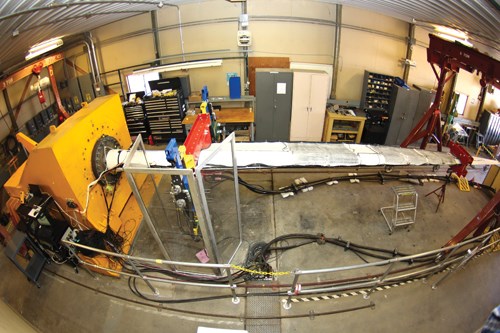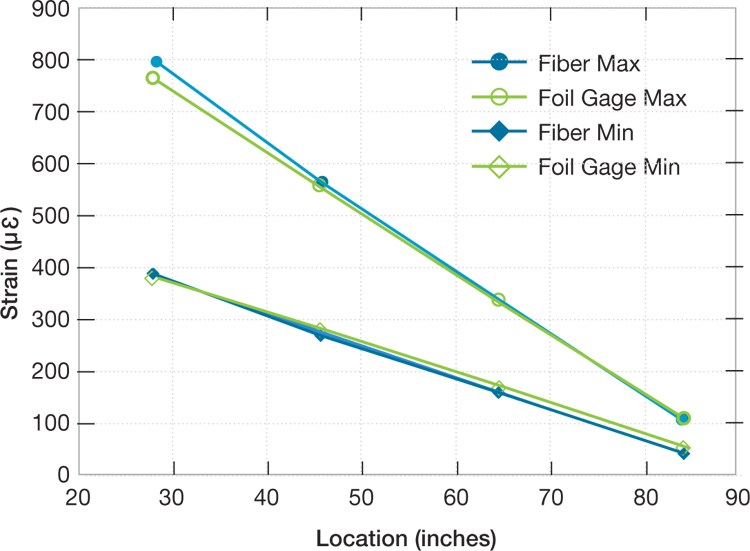Structural health monitoring: Angling for the air
Structural health monitoring (SHM) systems for composite aerostructures have been slow to deliver on their promise, but a system developed by Luna Technologies (Roanoke, Va.) is on a glide path to implementation on in-service aircraft
Share
In development for more than a decade, structural health monitoring (SHM) systems for composite aerostructures have been slow to deliver on their promise — they’re perpetual next-generation technologies. The premise of SHM is conceptually simple: integrate a series of sensors into composite laminates and other aerostructures to detect damage that might lead to failure of the structure and then alert (electronically, in real time) an onboard or ground-based crew to the type and location of the damage. In the aerospace world, however, no technology, no matter how straightforward, is speedily adopted. Every resin, fiber, adhesive, manufacturing process and SHM system, if it is destined to fly, must endure a rigorous testing and qualification process that makes speedy implementation impossible
Into that kind of heavy head wind Luna Technologies (Roanoke, Va.) is attempting to fly its SHM technology to market. Nonetheless, the company says it’s making substantial headway and expects, eventually to, implement it on a flying aircraft.
Working from technology developed at NASA Langley (Langley, Va.), Luna manufactures a dynamic distributed sensing system that uses the Rayleigh scatter of unaltered optical fiber as the sensor. With measurement rates of up to 100 Hz, cost-effective fiber sensors and significantly reduced installation time compared to equivalent foil strain gauges, this technology is designed to obtain dynamic strain data over a continuous object.
Rayleigh scatter is the light reflected from minute imperfections in an optical fiber. The scatter amplitude as a function of distance of a fiber is a unique, repeatable property of that fiber. A continuously tunable laser is used to spectrally interrogate the fiber. The reflected light from the scatter elements is then detected, demodulated and analyzed. Because the optical path difference between the reference reflector and each scatter reflection is different, the reflected signal from each scatterer is modulated by a unique frequency that is directly dependent upon the scatterer’s location in the fiber. As a fiber is subjected to environmental factors such as temperature or strain, the fiber is stretched or compressed, modifying the spacing of the scatter pattern and, thereby, its spectral response. When measured, this spectral change can be interpreted to determine the applied stimulus.
Mark Froggatt, Luna’s chief technology officer and developer of the company’s sensing technology, says optical fiber offers several advantages, including a relatively low cost (~$10/m), light weight, easy integration into composite structures and the ability to precisely measure temperature and strain at hundreds of points per meter of fiber.
Froggatt says Luna is attempting to get its technology accepted for use on flying aircraft. The starting point in this effort is implementation in design, test, verification and load frame testing, where Luna’s sensors replace foil strain gauges and the myriad wires that accompany them. Further, he notes, foil gauges typically fail at a few thousand microstrain, a value that optical fiber can easily exceed.
Dawn Gifford, Luna’s head of technology development, says the biggest advantages of the company’s fiber is easy integration with a composite structure and the ability to precisely detect and locate damage. “We’re going to sense whatever strain that fiber is experiencing at that location,” she says, adding, “We can detect the amount of strain around each defect.”
Real-world test
In an effort to prove that, Luna conducted a series of tests on a 9m/29.5-ft wind blade with carbon fiber spar caps, designed by Sandia National Laboratories (Albuquerque, N.M.) and manufactured at TPI Composites (Warren, R.I.). The blade featured intentional defects cast from resin prior to layup and introduced into the spar cap region of both the high-pressure and low-pressure sides of the blade at three span-wise locations. The wave height of all three defects was 3 mm/0.12 inch. Optical fibers were embedded in four layers of the composite structure. In all layers the fiber was routed in a straight line passing through points 2.54 cm/1.0 inch inboard of either end of the three defects. At approximately 1m/3.3-ft intervals, the fiber was woven into the composite material to maintain its position relative to the structure during the manufacturing process.
Following manufacture in Rhode Island, the blade was shipped to the National Wind Technology Center (NWTC, Boulder, Colo.) for additional instrumentation and pull, fatigue and property testing. In addition to the embedded fibers, optical fibers were bonded to the blade’s surface in areas of high and low pressure along its length. The fibers were offset from the spar cap centerline to coincide as closely as possible with foil gauges located on the centerline. Froggatt says the sensors not only pinpointed developing damage but also accurately predicted which load location would fail first.
“We want to succeed in the labs first, and then move out with the aircraft and into the air,” say Froggatt, noting that Luna also has placed its sensing technology in several military and commercial aircraft testing programs. Here, he notes, aircraft designers typically know what parts of the composite aerostructure are most susceptible to potentially damaging forces and, therefore, will place optical fiber selectively to monitor these regions more closely. In the air,
Luna’s system could be employed in either of two ways, says Froggatt. One way is to aggregate strain data from sensors via the company’s software and route it directly to the cockpit for flight-crew oversight. The other way is to aggregate and store data that could be accessed and assessed by maintenance crews on the ground between flights.
When could we see functional SHM systems on a flying aircraft? Froggatt and Gifford can’t say, but they see their recent progress and test results as promising: “Over the last few years, it has matured to become a very compelling technology,” says Froggatt.
Related Content
Plant tour: Joby Aviation, Marina, Calif., U.S.
As the advanced air mobility market begins to take shape, market leader Joby Aviation works to industrialize composites manufacturing for its first-generation, composites-intensive, all-electric air taxi.
Read MoreNext-generation airship design enabled by modern composites
LTA Research’s proof-of-concept Pathfinder 1 modernizes a fully rigid airship design with a largely carbon fiber composite frame. R&D has already begun on higher volume, more automated manufacturing for the future.
Read MoreInfinite Composites: Type V tanks for space, hydrogen, automotive and more
After a decade of proving its linerless, weight-saving composite tanks with NASA and more than 30 aerospace companies, this CryoSphere pioneer is scaling for growth in commercial space and sustainable transportation on Earth.
Read MoreASCEND program update: Designing next-gen, high-rate auto and aerospace composites
GKN Aerospace, McLaren Automotive and U.K.-based partners share goals and progress aiming at high-rate, Industry 4.0-enabled, sustainable materials and processes.
Read MoreRead Next
VIDEO: High-volume processing for fiberglass components
Cannon Ergos, a company specializing in high-ton presses and equipment for composites fabrication and plastics processing, displayed automotive and industrial components at CAMX 2024.
Read MorePlant tour: Daher Shap’in TechCenter and composites production plant, Saint-Aignan-de-Grandlieu, France
Co-located R&D and production advance OOA thermosets, thermoplastics, welding, recycling and digital technologies for faster processing and certification of lighter, more sustainable composites.
Read MoreAll-recycled, needle-punched nonwoven CFRP slashes carbon footprint of Formula 2 seat
Dallara and Tenowo collaborate to produce a race-ready Formula 2 seat using recycled carbon fiber, reducing CO2 emissions by 97.5% compared to virgin materials.
Read More



























